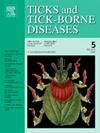Subolesin gene structure and mRNA isoform diversity in South African R. microplus ticks: Relevance for understanding subolesin-based tick vaccines
IF 3.4
2区 医学
Q2 INFECTIOUS DISEASES
引用次数: 0
Abstract
Designing a universal vaccine against ticks, capable of protecting a wide range of species, has long been an appealing goal. One antigen that has been proposed for a universal tick vaccine is Subolesin. Despite its intracellular and mostly nuclear location, this antigen has seen some success in bovine vaccine trials. The mechanism behind the observed efficacy remains elusive and may be due to various isoforms being produced in tick cells. By means of RNA sequencing and mapping to the annotated genome of R. microplus, this study confirms the presence of a single subolesin gene along with four distinct transcripts, resulting in three protein variants. However, none of the putative protein variants have extracellular location signals or known functional motifs. Furthermore, this study offers insights into the antigenic diversity of Subolesin isoforms and their expression across multiple life stages in R. microplus ticks from South Africa. This study also raise the question regarding the contrast between Subolesin's nuclear location, function, and its observed efficacy in bovine vaccine trials as an antigen accessible to the host immune system. Future studies evaluating antisera cross-reactivity with other tick proteins is therefore essential to fully understand subolesin as a protective antigen.
南非microplus蜱虫亚胚芽素基因结构和mRNA异构体多样性:与理解基于亚胚芽素的蜱虫疫苗的相关性
长期以来,设计一种针对蜱虫的通用疫苗,能够保护广泛的物种,一直是一个吸引人的目标。一种被提议用于通用蜱疫苗的抗原是苏波莱素。尽管这种抗原位于细胞内且主要位于细胞核内,但它在牛疫苗试验中取得了一些成功。观察到的功效背后的机制仍然难以捉摸,可能是由于蜱细胞中产生了各种同种异构体。通过RNA测序和标记基因组图谱,本研究证实了一个亚胚芽素基因的存在以及四个不同的转录本,导致三种蛋白质变异。然而,没有一个假定的蛋白质变异具有细胞外定位信号或已知的功能基序。此外,本研究还深入了解了南非小蜱在多个生命阶段中Subolesin亚型的抗原多样性及其表达。本研究还提出了关于Subolesin的核位置、功能及其在牛疫苗试验中作为宿主免疫系统可及的抗原所观察到的效力之间的对比的问题。因此,评估与其他蜱虫蛋白的抗血清交叉反应性的未来研究对于充分了解亚素作为保护性抗原至关重要。
本文章由计算机程序翻译,如有差异,请以英文原文为准。
求助全文
约1分钟内获得全文
求助全文
来源期刊

Ticks and Tick-borne Diseases
INFECTIOUS DISEASES-MICROBIOLOGY
CiteScore
6.90
自引率
12.50%
发文量
185
审稿时长
6-12 weeks
期刊介绍:
Ticks and Tick-borne Diseases is an international, peer-reviewed scientific journal. It publishes original research papers, short communications, state-of-the-art mini-reviews, letters to the editor, clinical-case studies, announcements of pertinent international meetings, and editorials.
The journal covers a broad spectrum and brings together various disciplines, for example, zoology, microbiology, molecular biology, genetics, mathematical modelling, veterinary and human medicine. Multidisciplinary approaches and the use of conventional and novel methods/methodologies (in the field and in the laboratory) are crucial for deeper understanding of the natural processes and human behaviour/activities that result in human or animal diseases and in economic effects of ticks and tick-borne pathogens. Such understanding is essential for management of tick populations and tick-borne diseases in an effective and environmentally acceptable manner.
 求助内容:
求助内容: 应助结果提醒方式:
应助结果提醒方式:


